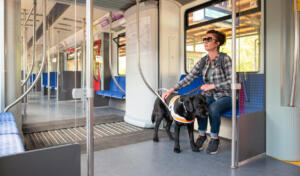Health equity and transit equity are linked in many ways. For example, according to the American Hospital Association, 3.6 million people skip needed medical care due to transportation issues each year.
But access to health care is only one of the ways transportation and health equity are connected. In fact, an estimated 50 percent of the factors that influence health are rooted in the broader community. These factors are called social determinants of health.
The Centers for Disease Control and Prevention (CDC) defines social determinants of health (SDOH) as “the conditions in the environments where people are born, live, learn, work, play, worship, and age that affect a wide range of health, functioning, and quality-of-life outcomes and risks.”

Social determinants of health are commonly grouped into five domains:
- Economic stability
- Education access and quality
- Health care access and quality
- Neighborhood and built environment
- Social and community context
You may notice that transit or transportation isn’t one of the five domains – that’s because it is strongly interrelated to all of them. Transportation is something most people living in the United States need to use every day, which affects every area of their life. Transportation provides access to opportunity. Nothing prevents access to jobs, education, or healthcare like the inability to get to work, school, or the doctor’s office or pharmacy. Transit is also key to a thriving neighborhood, a healthy environment, and a robust, interconnected community.
Stephen A. Martin, Jr., PhD, MPH, is an adjunct assistant professor of epidemiology at the University of Illinois at Chicago School of Public Health and served as health commissioner for suburban Cook County, Illinois, from 2002-2011. He told Genfare, “Access to public transportation is a critical component in a community’s ability to achieve their health goals because it has a direct and indirect impact on the social determinants of health.”
“You can’t have good health if you can’t get to work or the doctor or the grocery store,” Dr. Martin explains. “Employment is health. Economy is health. Infrastructure is health.”
The wide-ranging impact of transportation on social determinants of health
There is broad consensus of the huge role that access to transportation, including public transit and the infrastructure that supports it, plays on health and equity.

Stephen A. Martin, Jr., PhD, MPH
“As we focus on improving SDOH, the availability of public transportation is vital to our communities,” Dr. Martin says. “Especially in underserved communities including seniors, people with disabilities, and those living in socioeconomically disadvantaged areas. There are opportunities to do well here, and access to reliable public transportation has to be part of any planning conversation for a community to thrive and adapt to climate change, increasing globalization, and urbanization.”
The Healthy People 2030 health equity initiative of the U.S. Department of Health and Human Services states, “Just promoting healthy choices won’t eliminate health disparities. Instead, public health organizations and their partners in sectors like education, transportation, and housing need to take action to improve the conditions in people’s environments.”
Smart Growth America, in its Transportation: A Community Driver of Health white paper, summarized: “Transportation decisions affect everyone, by influencing where they live, how they can get to work and school, whether they can easily access health and other essential services, how they socialize with family members and friends, and ultimately if they can thrive in a physical environment that supports healthy outcomes.”
The American Hospital Association’s guide, Transportation and the Role of Hospitals, emphasizes: “Transportation is an economic and social factor that shapes people’s daily lives.”
Barriers to transit are barriers to health
Like health care, transportation is less accessible to the people who need it the most. Both have suffered from legacy policies that disproportionally harmed communities of color and low-income communities, both rural and urban.
Smart Growth America says, “Transportation plays a direct role in providing access to resources for vulnerable populations… but decades of policy decisions and infrastructure investments, coupled with racist land use policies, have resulted in serious transportation inequities in the United States.”
Public transportation barriers to health equity fall into categories including:
- Transportation infrastructure including limited availability and routes, overcrowding on trains and buses, transport stations and stops in disrepair, and safety issues
- Transportation costs such as high cost of fares, credit card or bank account requirements, and administrative burdens of distributing or obtaining free or reduced fare passes
- Distance and time burden like lengthy wait times or erroneous, inconvenient, or inconsistent schedules
- Policy decisions such as budget cuts resulting in transit shortages, route changes, and strikes, or lack of adequate transit in underserved urban and rural areas.
It isn’t surprising that such large inequities exist given that historically, 80 percent of federal investments went to roads, highways, and bridges, and less than 20 percent to public transit systems.
Likewise, benefits of transit are benefits to health
The economic, environmental, and social benefits of transit have direct and indirect benefits on health. For example:
Economy: 87% of trips on transit directly benefit the local economy – this breaks down to 50% of trips being to and from work and 37% of trips to shopping and recreational spending. Economic growth leads to healthier communities.
Environment: Public transportation reduces air pollution, climate change, fossil fuel usage, and other environmental factors by taking cars off the road and reducing traffic. For example, a bus with one quarter of its seats filled emits 33% lower greenhouse gas emissions per passenger mile than the average single-occupancy vehicle. The recent investment in transit vehicles powered by alternative fuels such as electricity and natural gas accelerates this benefit. Cleaner air, water, and soil and safer weather is healthier for all.
Connection: Transportation gives people access to their loved ones and others in their community, preventing isolation. Isolation is associated with a 50% increased risk of dementia and an approximate 30% increased risk of heart disease and stroke.

What can transit agencies do to address these issues?
The same strategies that elevate equitable mobility also enable health equity. Fortunately, the technology that drives these strategies is available today and is already showing results in the communities that have invested in it. Strategies include:
Incentivize ridership
Ridership fell precipitously during COVID-19. While it has been on the rise, the growth of telecommuting along with the lasting effects of pandemic-era staffing issues, budget constraints, and safety problems, has prevented ridership from returning to pre-pandemic levels. Consider creative marketing campaigns, working with employers to utilize transit benefit programs, and adopting more flexible pricing and fare payment programs.
Know your community and meet them where they are
Prioritize collecting data in a cloud-based system such as Genfare Link and analyzing it to make planning and operating decisions. Make it easy for riders to pay with whatever form of payment is in their pocket, whether it’s cash, a mobile application, or open payment. Remove barriers to money-saving digital payments for unbanked and underbanked riders using retail solutions to digitize cash.
Go multimodal
Integrate fare payment on fixed routes with flexible first-mile/last-mile and connecting modalities using a mobile trip planning application. Simplify transit for riders to make it easy to coordinate discounts, incentives, and trip planning across providers such as neighboring transit agencies, regional transit, bike and scooter share, ride share, and park and ride.
Enhance value and cost-effectiveness
Invest capital dollars in upgrading fare collection equipment to reduce the operational costs of collecting fares. Apply for Infrastructure Bill grants to fund new fareboxes and other capital improvements. Real-time monitoring and fare capping are other value-adds that come with new fare collection solutions.
Invest in green technologies
Replace aging fleets of petroleum-guzzling buses with low- or no-emission electric or natural gas vehicles. This will reduce operating costs while resulting in cleaner air and lower carbon emissions.
Partner with organizations
Develop relationships with education, health care, and social service organizations, along with large employers, to distribute subsidized, free, and reduced fare media to those who they serve. This will shift the administrative burden off the riders and your agency while increasing access to transit. The organizations can upload lists of their clients and encode fare media to give them. Genfare Link makes these partnerships easy to manage.
Participate in your community health assessment
Every three to five years, your local certified public health department and state department of public health both publish a community health assessment (CHA) which identifies key health needs and issues through systematic, comprehensive data collection and analysis for their respective jurisdiction.
“The next time a CHA invitation for your agency hits your desk, please give serious consideration to RSVP and participate. The insights and data that you will bring to the CHA and the opportunity to sit down with potential partners will be invaluable to your own agency’s transit planning,” says Dr. Martin. “If you have never received an invitation from or been contacted by these health agencies, please do not hesitate to contact them, and ask to be placed on their mail/email list to participate in the next CHA.”
How Genfare can help
For more information on how Genfare and our suite of fare collection solutions can be leveraged to elevate equitable mobility at your transit agency to raise health equity in your community, please contact the Business Development Director in your region.
- Josh Moskowitz | Business Development Director, Western Region
- Larry Chefalo | Business Development Director, Central Region
- Jennille Logan | Business Development Director, Southeast
- Edward H. Brandis, Jr. | Business Development Director, Northeast